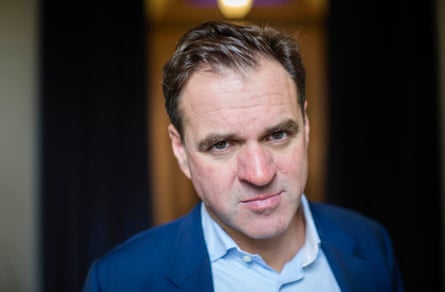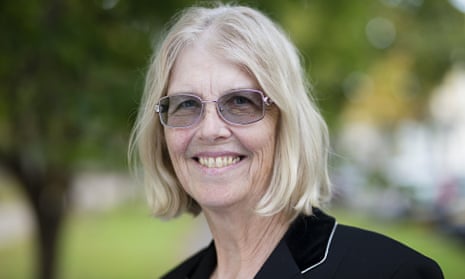In the late 90s, when I first went blond, I was driving to Santa Anita racetrack and I turned into the wrong entrance. I told a guard that I was looking for the main entrance, and he leaned forward, and said in a loud, careful voice: “OK. Go back out the way you came in, and then turn LEFT” (he demonstrated how to turn left by holding out his arms and making a left-turn gesture), “and then turn LEFT again [same gesture], and THAT’S the entrance.” Big smile. I wondered for a moment why he was treating me like an idiot, and then I realised that I was now a blonde! Since I am very tall, always wear jeans and can scowl with the best of them, being condescended to, even mansplained to, is something I have rarely endured, but it happened again this week, on Radio 4’s Start the Week. Only this time I was not condescended to as a blonde, I don’t think, but as a novelist.
The condescender was Niall Ferguson, a conservative historian about 15 years younger than me, who wanted to be sure that I understood that the historical novel is all made up, but that historical non-fiction, written by historians is truth. He referred to his research. I referred to my research. He wasn’t convinced. I suggested that the demands of history and fiction are slightly different – that since a novel is a story, it must be complete, and since a history must be accepted by the reader as accurate, it must be incomplete. He was not convinced. He kept talking, I subsided, the programme ended, but he did have the last word (apart from the host) – he and the other historian agreed that the historical novel – even War and Peace – was a secondary form, at least compared with what they were doing.

I do not consider literary forms to exist in a hierarchy; I think of them as more of a flower bouquet, with different colours, scents and forms, each satisfying and unsatisfying in its way, but if there is one thing that I do know about history, it is that it must be based on the author’s theory of what happened. He or she may change the theory as the research is completed, but without a theory, and if the research doesn’t fit into the theory, then the text has no logic, and therefore makes no sense. If it makes no sense, then readers will not read it. A history book is, therefore, a construct. Because of archaeology, because of archives, because of historians, we live in an age where historical novels as a form are having a bit of a boom. Reading Pulitzer prize-winning historical novelist Geraldine Brooks’s list of her favourite historical novels in a magazine this week, I can only marvel at the variety of subject matter: Alexander the Great, the Lewis and Clark expedition, Ovid, the American civil war. Of Wolf Hall, she writes: “Mantel seems to know Thomas Cromwell on the cellular level.” I am sure that my historian-of-the-day would say that such a thing is impossible in a mere novel, but I would say that such a thing is possible only in a novel, because the job of a novelist is to do her (or his) best to see the world through her character’s point of view – to imagine simultaneously what she and her subject are thinking and feeling as human beings, no matter how far apart they are, and also what is different about them – what has changed over the years and therefore indicates the passage of time and the change in the way people perceive things. This can be a challenge for a novelist, but it is also a pleasure, and the reason, after all, to write a historical novel.
Apart from my current trilogy, The Last Hundred Years, I have written three historical novels, one set in medieval Greenland, one set in pre-civil war Kansas, and one set in Missouri and California between about 1885 and 1945. Each presented different challenges, and of the three, the most recent was the hardest to write, simply because it was the most recent – there was much more material to sift through and understand before I could cook it together and produce that fragrant stew we call a novel. Private Life was about a nice, normal midwestern woman who realises that she has been married off to a crackpot and learns, for the most part, how to deal with him. My rule for myself as I wrote about the husband was that I could think of him as a crackpot, but I could not diagnose him with any modern definitions – I wanted to see him as my female protagonist would see him, to feel the mystery of his unruly personality without putting him in any kind of a box. I used a somewhat archaic style to mimic how she might have thought of him and of the world she lived in. It took me a long time, and many drafts, but I believed in it in the end (that is, I was willing to suspend disbelief and so were a fair number of readers). If my characters came alive and read my book, would they recognise themselves? I hope so. I did the research – into physics, into life in central Missouri and St Louis, into the lasting effects of the civil war, into the internment of the Japanese during the second world war, into ferries running between San Francisco and Vallejo in the old days, into the history of Mare Island as naval shipbuilding facility (the buildings are still standing, as are the houses lived in by the officers lived stationed there by the US Navy). As I looked at the houses, I imagined my characters opening the blinds, dusting the furniture, chatting with their neighbours, making their way through days and weeks and years in that chilly, cloudy, but often beautiful climate. As a result of my fascination (and research) I certainly know more about that weird spot and its history than many historians do. My motto as a historical novelist has been: “You are there.” But in order to put you there, I have to use my imagination to make connections, to evoke feelings, to show patterns, to build a logical structure. But then, my historian colleague must do the same. It is for the reader to decide which logical construct he or she believes.

Comments (…)
Sign in or create your Guardian account to join the discussion